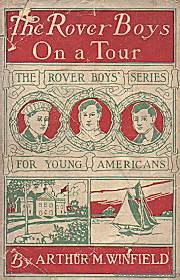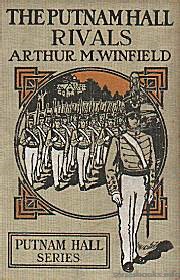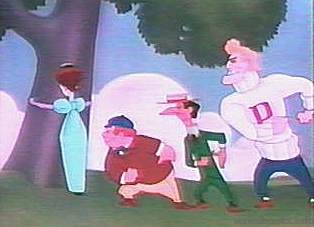the rover boys series
|
 Mershon  Wanamaker  Chatterton-Peck  G&D green 1st series  G&D brown 2nd series  G&D Orange G&D Orange
|
The first highly successful series by Edward Stratemeyer, each volume had a preface from Edward Stratemeyer himself, thanking his readers and touting the other books. It's generally accepted that Stratemeyer wrote all of the books. He is on record as stating it is his favorite series. Volumes 1 - 11 of this series were published by Mershon (starting 1899), then Stitt (starting 1905), then Chatterton-Peck (starting 1907). All these books are very difficult to locate. In 1902-1904 John Wanamaker reprinted at least volumes 1-5 using the Mershon plates (with a modified title page) and internal illustrations as part of the Wanamaker Young People's Library. There appear to be two binding styles and various binding colors have been seen (green, olive, maroon). The Wanamaker reprints are of a very high quality (better than the Mershon editions) and are the rarest of all Rover Boys editions. In 1908, Grosset & Dunlap reprinted all the earlier volumes and continued to produce all succeeding Rover books. The G&D books came in 3 binding styles (green, brown, orange) and 2 types of dustjackets (2 color and full color - all of which were the same for every title). The green and brown bindings are illustrated (imitating the design of the earlier publishers) and had plain white endpapers, while the orange binding is not illustrated and had green striped endpapers. Sometime in the late 1930's or early 1940's Whitman Publishing reprinted volumes 1, 2, 7, 8, 10, 11, 13, 14. All new full color dustjackets were created for these books. They contain no internal illustrations. Starting with volume 21, the stories recounted the adventures of the four sons of the original three Rover Boys (Tom, Dick and Sam), who by that time had married and settled into adjoining brownstones on Riverside Drive in New York City. Arthur Prager's book Rascals At Large has a chapter devoted to the antics of the brothers Rover and I recommend it to all fans. A Rover Boys PrimerIn the original series, the Rover Boys consist of brothers Dick (the eldest), Tom and Sam (the youngest). They are the sons of wealthy businessman Anderson Rover and live on a Hudson River valley farm with their uncle and aunt, Randolph and Martha Rover. The Rovers have the distinction of being the most high-handed and obnoxious series book "heroes" ever. Brother Tom, the "practical joker", is a borderline psychotic who indulges in "jokes" so cruel, mean and dangerous that they would no doubt land anyone else in jail or, at least, in civil court. Wherever they go, the Rovers are snobbish, haughty, condescending and downright mean to all they meet. What is even more amazing is that these people accept the Rovers' obnoxious behavior with an obsequiousness normally reserved for Oriental potentates and extremely rich, superannuated relatives. In the first 12 volumes, the Rovers were students at Putnam Hall, a military academy run by family friend, Captain Putnam. Their adventures while attending this institution took them far and wide on land, sea and in the air. After leaving Putnam Hall, the boys went on to college and eventually into business and, finally, marriage - an event which triggered the Rover Boys Second Series. The Rovers were a lusty lot and wasted no time making the acquaintance of Dora Stanhope and her cousins Grace and Nellie Laning. Their "friends" included would-be poet John "Songbird" Powell, the dudish William Philander Potts (who was subjected to the brunt of Tom's practical "jokes") and the fat German Hans Mueller (subject of much low ethnic humor) among others. Handyman Alexander Pop, one of the typical shuffling, eye-rolling Negroes so prevalent in early Stratemeyer works, also bore the brunt of much low humor. Their main foes were Josiah Crabtree, a professor at Putnam Hall who had a hypnotic hold over Mrs. Stanhope and lusted for her fortune; Dan Baxter and Tad Sobber (among others) were fellow students who constantly battled the Rovers. The Second Series presented the reader with Dick and Dora's offspring Martha and Jack, Tom and Nellie's twins Andy and Randy and Sam and Grace's progeny Fred and Mary. The girls were quickly packed off to boarding school and were seldom heard from again. Meanwhile, the four cousins, while attending the Colby Hall academy run by old family friend Larry Colby, had a series of adventures that closely parallel those of their fathers.
Introduction from Volume One:
Illustrators
MY DEAR BOYS: "The Rover Boys at School" has been written that those of you who have never put in a term or more at an American military academy for boys may gain some insight into the workings of such an institution. While Putnam Hall is not the real name of the particular place of learning I had in mind while penning this tale for your amusement and instruction, there is really such a school, and dear Captain Putnam is a living person, as are also the lively, wide-awake, fun-loving Rover brothers, Dick, Tom, and Sam, and their schoolfellows, Larry, Fred, and Frank. The same can be said, to a certain degree, of the bully Dan Baxter, and his toady, the sneak commonly known as "Mumps." The present story is complete in itself, but it is written as the first of a series,. to be followed by "The Rover Boys in the Jungle," in both of which volumes we will again meet many of our former characters. Trusting that this tale will find as much favor in your hands as have my previous stories, I remain, Affectionately and sincerely yours, Arthur M. Winfield W.B. Bridge (1-6) frontispieces only Stacy Burch (1-6) internals anonymous (7,8) A . Burnham Shute (9,10) Charles Nuttal (11-14) Walter S. Rogers (15-17, 19-30) Dick Richards (18)
The Rover Boys Seriesor, The Cadets Of Putnam Hall - 1899 or, A Chase For Fortune - 1899 or, Stirring Adventures In Africa- 1899 or, The Search For The Lost Mine - 1900 or, The Secret Of The Island Cave - 1901 or, A Hunt For Fun And Fortune - 1902 or, The Crusoes Of Seven Islands - 1903 or,The Rivals Of Pine Island - 1904 or, The Search For The Missing Houseboat - 1905 or, The Mystery Of Red Rock - 1906 or, The Deserted Steam Yacht - 1907 or, Last Days At Putnam Hall - 1908 or, The Strange Cruise Of the Steam Yacht - 1909 or, The Right Road And The Wrong - 1910 or, The Struggle For The Stanhope Fortune - 1911 or, From College Campus To Clouds - 1912 or, Saving Their Father's Honor - 1913 or, Lost In The Fields Of Ice - 1914 or, The Search For The Missing Bonds - 1915 or, Last Days At Brill College - 1916
The Rover Boys Second Seriesor, The Struggles Of The Young Cadets - 1917 or, The Old Lumberman's Treasure Box - 1918 or, The Mystery Of The Wrecked Submarine - 1919 or, The Mysterious House In The Woods - 1920 or, Stirring Adventures In The Oilfields - 1921 or, The Cowboys' Double Round-Up - 1922 or, The Camp Of The Rivals Cadets - 1923 or, A Thrilling Hunt For Pirates Gold - 1924 or, The Old Miner's Mysterious Message - 1925 or, Strenuous Days Afloat And Ashore - 1926 Kindle Editions: First Series - Second Series |  G&D DJ style 1  G&D 2nd Series DJ  G&D DJ style 2  Whitman DJ |


 This series recounts the adventures of the boys of Putnam Hall before the Rover Boys arrived. Many characters in this series also appear in the Rover Boys series although the Rover Boys themselves do not make an appearance here.
This series recounts the adventures of the boys of Putnam Hall before the Rover Boys arrived. Many characters in this series also appear in the Rover Boys series although the Rover Boys themselves do not make an appearance here.

